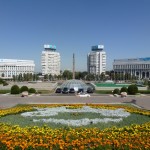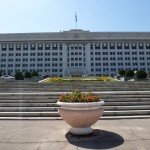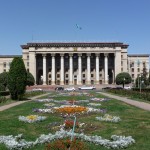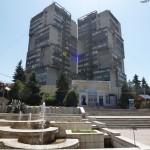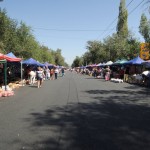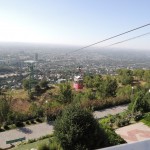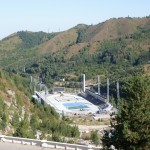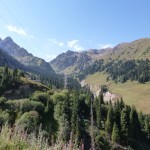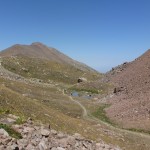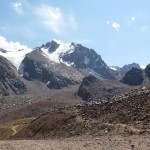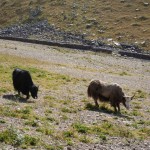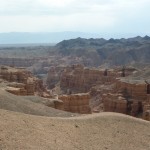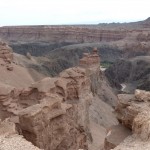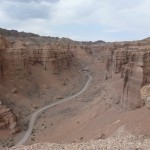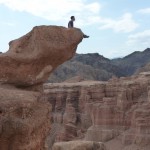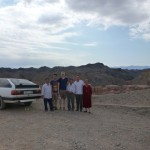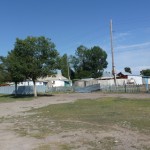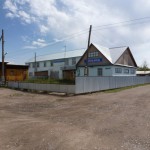Without really knowing what would expect us during the following 4 weeks, we started our journey in Almaty, Kazakhstan’s most important hub (but not capital, since it has been replaced by Astana). Living in decent Almaty Backpackers Hostel, we spent the first day walking through this nice city along modern apartments, Soviet style monuments and avenues, countless water fountains and lots of very green parks, which together with the unobtrusive people give the city a relaxed atmosphere. Additionally, we were quite impressed by the number of Audis, BMWs and Mercedes and realized how wealthy Almaty and its inhabitants are. And most important, I could finally enjoy dry warm weather after Germany’s horrible summer, whereas the dust admittedly prevented a clear view from Kok-Tobe Hill over the whole town.
As Almaty is bordered by the Tian Shan Mountains, we also went for a hike to nearby Medeu and Shymbulak. Although it surely helps Almaty’s large middle-class enjoying their life to the full, this new ski-resort is not the best place for hiking, because unfortunately many recently built modern lifts and ski runs have destroyed big parts of the nature. In fact we had to ascent 1500m straight on steep dry tracks until we eventually reached an area worth trekking. At least we were rewarded with a beautiful view over 4000m snow-covered peals and glaciers and enjoyed climbing additional 500 meters of altitude over stones and rocks to find the best spots. Having to descend all the way again was extremely exhausting but we will take it as good training for further treks ![]()
Next we started making our way towards Kyrgyzstan via the deep south-east Kazakh mountains and valleys (that are also adjacent to China) and soon discovered what probably is much more representative to Kazakhstan: endless lonesome roads through a vast dusty steppe, with a few horses, cows or sheep and occasionally some Nomads’ yurts. We had a stop at stunning Charyn Canyon where we stood on and under big colorful cliffs and walked through a dried up river bed (thanks to the old former Soviet soldier who drove us the 10km walking distance such that we could enjoy more time at the actual site). This is also where we first got into touch with Central Asia’s hospitality and openness we had heard so much about: an elderly group consisting of one Kazakh, two Uzbek and one Uyghur gave us a warm-hearted welcome, wanted to have an “international” group picture taken and we could manage to communicate at least a little bit with a few chunks of Russian, English and Turkic. My poor Russian skills also turned out to be at least sufficient to persuade a young couple to take us further to Kegen, the last place we would stay before heading to the Kyrgyz frontier. We had some basic small-talk in English and Russian during the ride and they even helped us to find a “gostinitsa” after dropping us off.
In Kegen we continued being welcomed by casually hospitable and interested people: the owner of the guesthouse, a woman who surprisingly could speak a little German, and Karkin – a well-educated digital television technician with whom we spent the whole evening together. He insisted on inviting us and thanks to his good English (he also knows Kazakh, Russian, Turkish and Chinese) we talked a lot about the Muslim South-Kazakh culture and traditions, which is quite different from the Russian-influenced north. Yet almost everyone has no problems with drinking alcohol. Especially one topic we discussed was about how to get married. Of course, we were offered the daughter of the funny restaurant’s owner, but soon were told that unlike other countries (e.g. India) it is the groom who has to bring the dowry (rather exigent – around 3000 US dollars, jewellery for her mum and a horse or camel for her father). Luckily one important aspect they wanted to point out is that apparently the future bride has the right to influence the choice as well and is not forced into someone totally foreign to her. Or to quote our new friend: “We Turks (Kazakhs, Uzbeks, Kyrgyz, Turkmen) are all democratic and have love weddings, we are definitely not like Arabs in this case.”
Apart from that, Kegen is interesting to see simply because there actually is nothing to see or do there, it is a rather small village between sandy hills and steppe, giving a typical glimpse at Kazakhstan slightly bleak countryside. So except all these great acquaintances and human experiences nothing here really kept us from continuing our journey ….
+++ quick facts +++
- average costs per person per day (including everything like accommodation, transport, food, entrance fees, except intercontinental flights): 32€
- to do: improve my Russian!
- not to do (as we were told): never go to north Kazakhstan (including Astana) because it is just too cold up there

- new top ranking award: they are the fastest and craziest drivers – one of our taxi drove up to 150km/h on bad roads, overtook everyone everywhere no matter how impossible or unsuited the situation, all this while smoking and listening to loud Modern Talking music. Even a fine from the speed control police did not reduce his energy …. but we are still alive yet!
